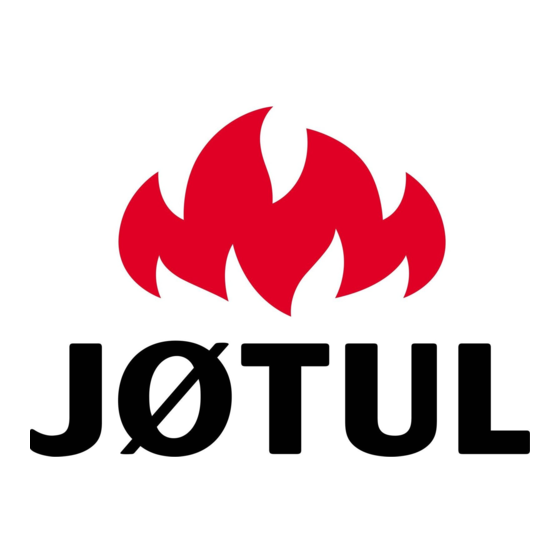

Jøtul GF 305 DV IPI Manual
Ceramic burner
Hide thumbs
Also See for GF 305 DV IPI:
- Installation and operation instructions manual (48 pages) ,
- Quick start manual (4 pages)
Advertisement
Quick Links
Service should only be performed by a
licensed gas service technician. If these
instructions are not followed exactly, a
fire, explosion, or production of carbon
monoxide may result causing property
damage, personal injury or loss of life.
CAUTION:
THE IGNITION SYSTEM OF THE IPI
APPLIANCES CARRIES LIVE VOLTAGE.
ALWAYS TURN OFF THE GAS SUPPLY
TO THE FIREPLACE AND DISCONNECT
THE POWER SOURCE BEFORE ANY
SERVICE WORK IS PERFORMED,
INCLUDING BATTERY REPLACEMENT.
CAUTION:
DO NOT CLEAN BURNERS WHEN
FLAMES ARE PRESENT OR WHEN HOT
ALWAYS REFER TO THE LIGHTING
INSTRUCTIONS ON THE INSIDE BACK
COVER OF THE OWNERS MANUAL WHEN
LIGHTING THE STOVE.
WARNING
DO NOT ALLOW THE INLET GAS PRES-
SURE TO EXCEED 14.0" WC (OR 1/2 PSIG)
AS SERIOUS DAMAGE TO THE VALVE
MAY RESULT.
Contact Jøtul Technical
Department at 1-800-797-5912
EXT. 108 for further assistance if
you have any questions regarding
these procedures.
1
Ceramic Burner Guide
Setup and Test Firing
This guide is intended to stress the importance of a correct
setup and provide important information regarding proper
troubleshooting, and maintenance procedures for all Jøtul
models equipped with ceramic burners. Each burner is
unique to that particular appliance, however, the same
instructions will apply to all unless otherwise specified.
Initial Setup
The stove must have the initial set up performed as
instructed in the owners manual prior to observing pilot
appearance and measuring inlet pressure. This will include:
•
Gas connection and leak test
•
High altitude adjustment kits
•
Any brick or reflective panels
•
Log sets
•
Ember Placement - Ensure pilot carry over ports are not
blocked
•
Any other accessories
For all models, the glass panel must be removed prior to
initial setup and testing.
For the GF 500 DV/DV MV/IPI, the top convection shroud
bolts can be loosely put into position and the shroud left off.
Testing Inlet Pressure
& Burner Function
Confirmation
The following tests must be conducted to confirm correct
system performance. Pilot ignition performance is highly
dependent on the pilot always having adequate supply
pressure ensuring pilot flame size to reach burner.
VERY IMPORTANT
The following steps 1-5 should be conducted
with the glass removed.
1. Pilot Appearance
Turn gas on and light the pilot. Observe pilot flame strength
and alignment with the burner. The pilot flames should be
blueish-yellow in color and extend approximately 1" (25 mm)
over to the first two burner ports and flame sensor (PSE - IPI
stoves) or thermopile and thermocouple (SIT 820 - Standing
Pilot stoves). Each flame should be strong and steady - not
fluttering or lifting. See figs. 1-4.
130031 Rev C, Jøtul North America, Inc. 55 Hutcherson Dr. Gorham, Maine
Jøtul GF 305 DV IPI
Jøtul GF 500 DV/DV MV Portland
Jøtul GF 500 DV IPI Portland
Jøtul GI 535 DV IPI New Harbor
Jøtul GI 635 DV IPI Newcastle
Dec. 2019
Advertisement

Summary of Contents for Jøtul GF 305 DV IPI
-
Page 1: Initial Setup
Ceramic Burner Guide Setup and Test Firing Jøtul GF 305 DV IPI Jøtul GF 500 DV/DV MV Portland Jøtul GF 500 DV IPI Portland Jøtul GI 535 DV IPI New Harbor Service should only be performed by a Jøtul GI 635 DV IPI Newcastle licensed gas service technician. - Page 2 4 seconds. 4. Manifold Pressure All NG Manifold Pressures will range between Fig. 3 GF 305 DV IPI Pilot Flame 1.1-3.8” (±0.3) WC. You should never observe less than 1.1’’ WC on Low. Contact Jøtul Technical service for regulator replacement.
- Page 3 Troubleshooting Tips 3. Remove burner system from unit and flip over. Clean using canned or compressed shop air through venturi tubes. DO NOT USE BRUSH OR VACUUM TO Observe the following items if your test results do not CLEAN BURNER. See fig. 7 meet specifications.
- Page 4 REMINDERS ! Annual Maintenance and Cleaning Tips Observe the following items for annual maintenance and cleaning. Follow the owners manual for specific annual cleaning requirements. ˆ ALWAYS Inspect the burner for embers, log set movement or any other debris that may cause obstructions of carry-over ports or convection airways.





